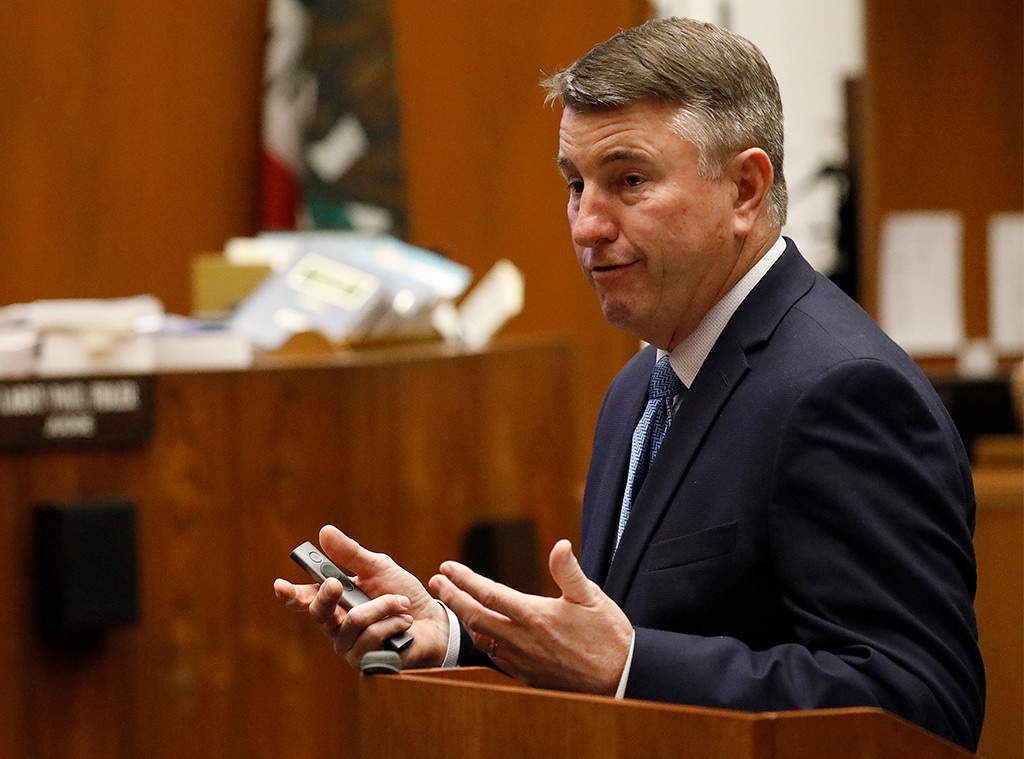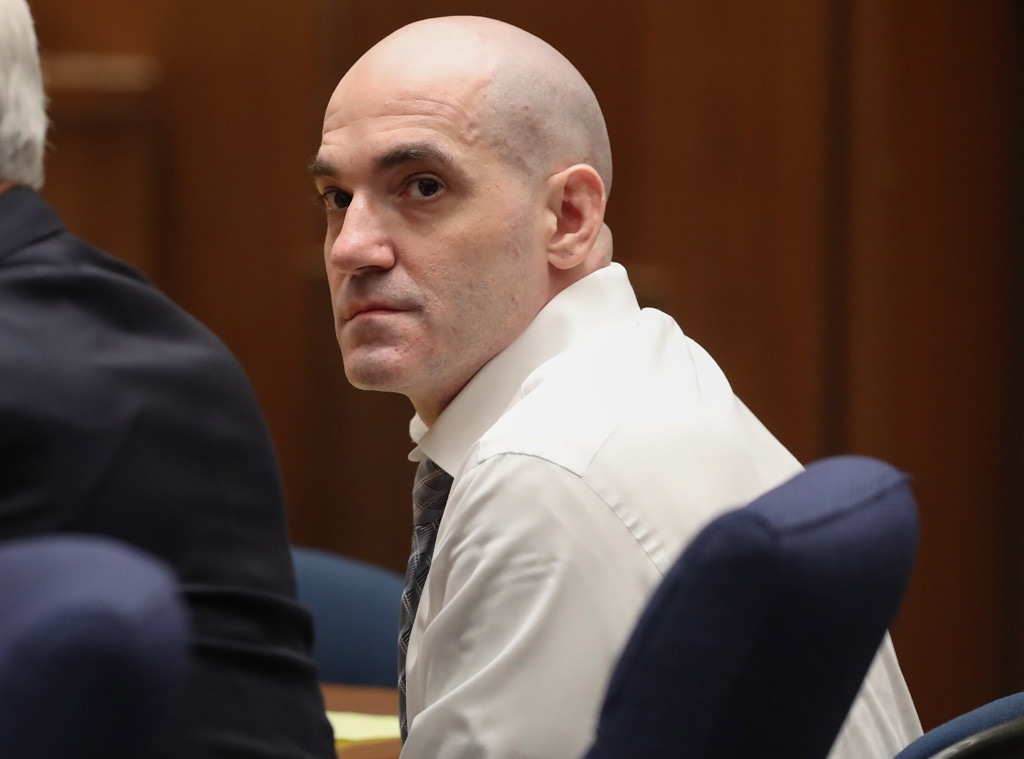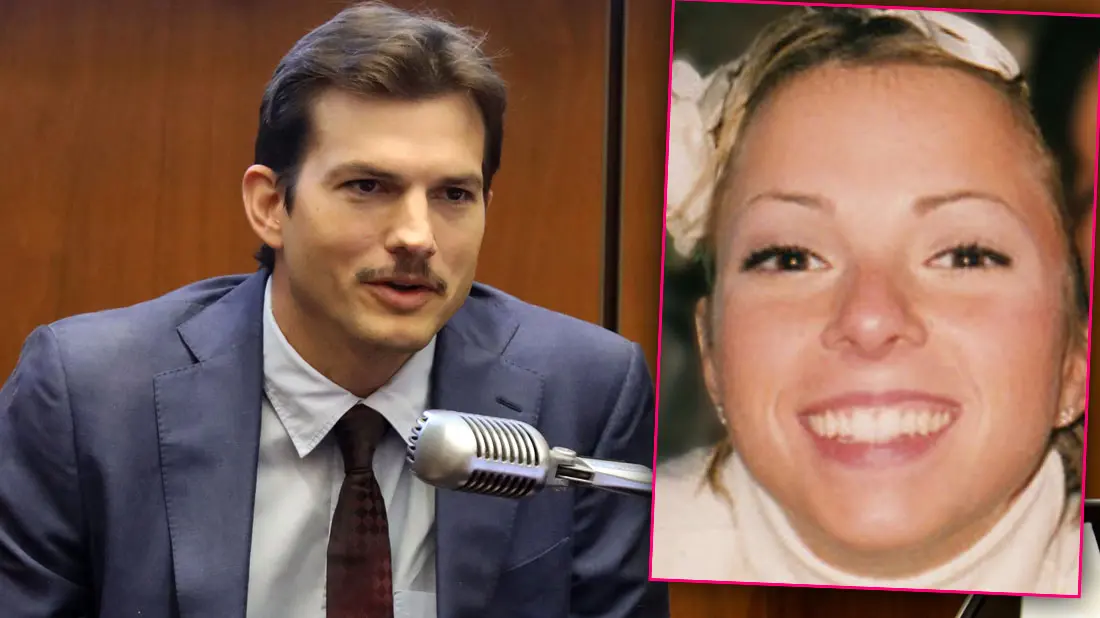The Chilling Details of the Murder of Ashley Ellerin and the "Hollywood Ripper" Trial
In February 2001, Ashton Kutcher arrived to pick Ellerin up for a date—but she didn't answer the door because she had already been stabbed to death by accused serial killer Michael Gargiulo
On Oct. 18, 2019, a jury recommended that Michael Gargiulo be sentenced to death for the murders of Ashley Ellerin and Maria Bruno. Sentencing is scheduled for Feb. 28, 2020.
__________________________
The story is like something out of a terrifying movie, only it's all too real.
Michael Gargiulo, 43, has been found guilty of murdering two women and the attempted murder of another, the jury deliberating for three days before returning with their verdict on the morning of Aug. 15 following a three-month trial—and almost two decades of waiting for the victims' families.
Prosecutors stated that, on the night of Feb. 21, 2001, Ashley Ellerin had just gotten out of the shower and was about to get ready for a night out when Gargiulo stabbed her to death.
Ellerin's body, lying just outside the entrance to the bathroom, wasn't found until about 9 a.m. the next day, when her roommate, Jennifer Disisto, returned to the rented bungalow they shared on Pinehurst Road in Hollywood. Paramedics pronounced Ellerin dead at 9:28 a.m. on Feb. 22. She had been stabbed 47 times, with 12 of the wounds considered fatal on their own, and there were numerous defensive wounds on her hands and right forearm.
In a strange only-in-Hollywood twist, Ashton Kutcher, who was starring on That '70s Show at the time, had been her date for the prior evening. He later told police—and testified in court on May 29—that he had last talked to Ellerin at 8:24 p.m. to confirm their plans. They were supposed to attend a Grammys after-party together. He called again shortly after 10 p.m. when he was on his way over, but she didn't pick up. The actor knocked at around 10:45 p.m., he said. There was no answer. He peered through the window and recalled seeing what to him looked like spilled wine on the carpet.
Her car was in the driveway, but he thought she might be mad at him because he was late and purposely not answering, so he left.
"He believed at that point he had been stood up," Los Angeles County Deputy District Attorney Dan Akemon said in his opening statement as Gargiulo's trial got underway in May. "We believe now the evidence will show that was actually blood, and Ashley had already been murdered."

Ellerin, 22, was a student at L.A.'s Fashion Institute of Design and Merchandising (FIDM) as well as a part-time stripper, and, according to Kutcher's testimony, she had met the actor in December 2000 through friends.
"She had tons of boyfriends," LAPD Homicide Detective Tom Small told LA Weekly in 2010. "At that time Kutcher was still coming up. He hadn't established his big-time credentials yet. They met through a mutual friend. It was a friendly thing. They went out a couple of times."
Kutcher said in court that he was dating someone else when he first met Ellerin, so he introduced her to a buddy and the two of them briefly dated.
He then went to Ellerin's home about two weeks before she died for a housewarming party and, both single by then, they made plans to get dinner and drinks.
On Feb. 21, 2001, the original plan was for him to pick her up at 8 p.m., but he was invited to watch the Grammys at a friend's house. He said in court that he called Ellerin at around 7:30 to tell her he'd be later than 8, then called again to keep her posted on his whereabouts. He left a voicemail, then she called back from her roommate Jen's phone, saying the house phone wasn't working. It was 8:24 p.m. She told him she was just out of the shower and was going to dry her hair, Kutcher recalled, so his lateness wasn't a problem.
One of the first detectives at the scene later recalled seeing a blow dryer on the toilet seat.
According to Kutcher, shortly after 10 p.m. he called to say he was on his way over, and there was no answer. He decided not to go straight there, Kutcher said, because he didn't want to just show up without touching base. But when he got there at 10:45, he thought perhaps she was mad at him for being so late and that's why she wouldn't come to the door. He did try the front door, he testified, and it was locked.
Talking to police the next day, he recalled during cross-examination, he was admittedly "freaked out" because he knew his fingerprints would be on the doorknob and he tried to share every little detail he could remember with detectives.
"Don't worry, you're not a suspect," defense attorney Daniel Nardoni humorously assured him.

According to the prosecution, Ellerin first crossed paths with Michael Gargiulo several months before her death. Gargiulo lived nearby, with a girlfriend, and he had seen Ellerin and a friend outside her place in the fall of 2000. Gargiulo approached to ask if he could help them fix a flat tire, and then he gave them a business card advertising his air conditioner repair services.
While Gargiulo may have been a legitimate repairman, the Los Angeles District Attorney's Office alleges he is also a "serial sexual-thrill killer"—dubbed the "Hollywood Ripper" and also the "Boy Next Door Killer" in media reports—whose crimes include the 1993 murder of 18-year-old Tricia Pacaccio in Chicago, where Gargiulo, who's from Illinois, lived before moving to L.A.
Gariulo was also convicted Thursday of the 2005 killing of 32-year-old Maria Bruno in El Monte, Calif., and the attempted murder in 2008 of Michelle Murphy, who survived being attacked with a knife and was the prosecution's first witness when the trial began three months ago after years of delays.
He's charged with first-degree murder in Pacaccio's slaying in Chicago and is expected to be extradited to stand trial after the proceedings in L.A. officially conclude.
Gargiulo, who pleaded not guilty to the attacks on Bruno, Ellerin and Murphy, has also denied killing Pacaccio.
He has been in jail since being arrested on June 6, 2008, after attacking Murphy.
Gargiulo "was kind of a braggart and bulls--t artist," L.A. County Sheriff's Detective Mark Lillienfeld, who investigated Bruno's death, told LA Weekly in 2010. "He told a number of people he was in the movies and was a high-end plumber for celebrities, and was friends with them. He would meet and befriend and associate with these women, and form a superficial relationship with them—and ultimately they would end up dead. He's every woman's nightmare."
Gargiulo was said to have talked about Chicago to Ellerin and her former roommate Justin Peterson, who said he confronted Gargiulo once, the day after he saw him parked outside their house in the early morning hours.
"He started to go on about how the fact that he couldn't go home last night," Peterson told 48 Hours, "because the FBI was waiting for him at his home to collect DNA samples from Chicago, some case or some murder, his best friend's girlfriend was murdered, or whatever. And I said, 'Well, what do you have to hide?' And he immediately put his leg up on the couch, and started to pull out a knife that was, like, you know, strapped to his ankle. At that point, I rushed him out of the house."
Prosecutors are seeking the death penalty for the murders of Ellerin and Bruno. They allege Gargiulo was hiding in plain sight with the perfect cover—a steady job, a wife and a child.
"What no one knew for many years is that Michael Gargiulo was leading a double life," Akemon charged.

Friends of Ellerin told police that, after she met him, Gargiulo, who lived a block away, at one point fixed her heater, but then would show up uninvited to the bungalow, and on multiple occasions he was spotted parked outside, seemingly watching the place.
"Ashley knew I had 'an occurrence' with him and she knew how I felt," Justin Peterson later said, LA Weekly reported in November 2010. "She didn't seem concerned. She was an amazing person who would make friends with everyone."
"Probably someone came to the door," Detective Tom Small said, "and the rest is history. She knew the guy, and according to the people who knew her, if she knew you, she would let you in."
"A sense of trauma just came over me," Jennifer Disisto told 48 Hours in 2011, recalling how she found Ashley's body. "I thought maybe the person was still there, and I kinda ran out, and getting to the car... and calling from my cell phone, 911... It still traumatizes me to this day."
After a pretrial hearing (Kutcher did not testify then; a detective who interviewed him testified as to what the actor told him), a judge ruled on June 30, 2010, that the case should proceed to trial. No date was set, but surely no one thought it would take almost nine years to get underway. According to the Los Angeles Times, the decade-long delay in trying this case is largely due to Gargiulo switching attorneys several times, and for about three years he was representing himself.
"There was a...very narrow window of opportunity for someone to get into the house and murder Ashley, and whoever that person was must have been watching," Akemon said in court. Kutcher's testimony was used to help establish the timeline of alleged events. His was one of about 250 names on the list of potential prosecution witnesses in the case.
Daniel Nardoni, Gargiulo's attorney, countered in his opening statement that the prosecution wouldn't be able to present any physical evidence that tied his client to Ellerin's death.
"The information we have is that [the suspect] introduced himself [to the victim] as a heating and air guy," Small told 48 Hours in 2011. "Ultimately got some additional information. Was able to come up with some photos and identify him as Michael Thomas Gargiulo."
Four years after Ellerin was killed, the criminal complaint further alleged, Gargiulo "quite literally butchered" his neighbor Maria Bruno in her El Monte apartment.
"Apartment No. 20 is where Maria Bruno lived," Lillienfeld told CBS News' 48 Hours in 2011. "So, he kind of has a pretty clear shot, if he's looking through the window right down to her place. He has a very clear shot at her front door, and both living room window and the kitchen window."
She had been killed in bed; her husband, Irving Bruno, who she was separated from, found her mutilated body. He told the 911 dispatcher that her breasts had been slashed off and one of her nipples placed over her mouth.
Investigators found a blue surgical bootie with a few drops of Bruno's blood on it outside her front door; they say that DNA from its elastic band later matched with Gargiulo, and they found similar booties, which he apparently wore for work, in the suspect's attic when they searched his home.
"She was a mother and a wife and a daughter and a sister," Lillienfeld said about Bruno on 48 Hours. "She was all those things. She had come to this country from El Salvador as an adolescent...She met and married her husband when she was a young woman...she had 2-year-old twins and then I believe a 4-year-old and a 5-year-old."
Also acording to the Los Angeles D.A.'s criminal case, Gargiulo was 17 when he fatally stabbed Tricia Pacaccio outside the front door of her family's home in the upscale Chicago suburb of Glenview in August 1993. Her dad found her the next morning with wounds to her neck, shoulders and chest. She was a recent high school graduate who was scheduled to start at Purdue University a week after she was killed.
At one point, Gargiulo implicated a friend of his in Tricia's murder, but later recanted his statement. A decade later, tests showed that DNA collected from under Tricia's fingernails belonged to Gargiulo, who was a friend of her younger brother.
Though the DNA match was made in 2003, Gargiulo wasn't charged with Pacaccio's murder until 2011 when two witnesses came forward after watching a 48 Hours special about Gargiulo—an unsatisfactory turn of events for the girl's parents, who slammed a previous explanation that the DNA alone wasn't enough to arrest him because it could have come from "casual contact."
They suggested that Gargiulo would never have been charged in Chicago if he hadn't been charged with murder in L.A. first., and that perhaps two other women would be alive if more had been done more in the first place.
"My husband and I both feel that what Cook County did is, once they found DNA, instead of pursuing Michael, they made false excuses on why DNA was on her. How pathetic," Tricia's mother, Diane Pacaccio, told Chicago magazine in 2011.
"As long as he murdered only my daughter, they didn't care. They didn't do anything about it," she said. "They were willing to leave it an open case forever. Again, how pathetic."
"[The Cook County detectives] actually went back over this stuff and did everything they could," Detective Small told LA Weekly in 2010, before Gargiulo was charged in Chicago. "It was the State's Attorney's Office that is not filing...I am not privy to everything in their investigation. In totality of the circumstances and physical evidence out here, we would prosecute it. Frankly, I think it is a bunch of shenanigans, but it is not my say."

Helping the Cook County case along, two witnesses identified at the time as "Witness D" and "Witness E" had come forward in L.A. to say that Gargiulo told them he had killed someone in Chicago, information he reportedly confided in the late 1990s while working with "D" and "E" at the Rainbow Bar & Grill on Sunset Boulevard, where he was a bouncer. According to LA Weekly, he was fired from that job, which he held in 1999, after he hit a customer.
The July 2011 warrant for Gargiulo's arrest in the Pacaccio murder, obtained by the Chicago Tribune, stated that he had told "D" that he had stabbed someone and at first told "E" he had buried a body, but then said, "'I'm only kidding. I actually left the bitch on the step for dead.'"
Some of Pacaccio's family members are on the witness list for this trial as well.
"Fighting for this case goes on with me forever," Diane Pacaccio told reporters this month. "And that's the way it's gonna be."

"All of the victims were young, outgoing women, all of the attacks occurred at night, all of the victims suffered multiple stab wounds, all of the victims were stabbed with the knife, each of the victims was attacked in or around her home and in close proximity of Mr. Gargiulo," Dan Akemon said in court.
After Michelle Murphy was attacked in the bedroom of her Euclid Avenue apartment in Santa Monica in April 2008, DNA collected from that scene was matched through a national database with samples collected from the Pacaccio crime scene.
"About 25 days after submitting my samples to the crime lab, I'm informed by a criminalist that...we actually have a hit, a DNA hit," Santa Monica Police Sgt. Richard Lewis told 48 Hours in 2011. "A profile that was determined I did get a match."
Gargiulo was arrested 24 hours later. He was subsequently charged in Ellerin's death and then Bruno's that December.
Living in Santa Monica in 2008, the suspect shared an alley with then 26-year-old Murphy, and she told police that they had greeted each other outside on occasion.
She had been sleeping for about an hour on the night of April 28, 2008, when she was stabbed in her bed, Murphy testified this month. She managed to fight off her attacker by grabbing the knife blade with both hands and was able to kick him off of her. At some point in the struggle he cut his wrist, leaving some of his blood on her bedspread and trailing into the alley out back. She recalled the man saying, "I'm sorry," as he ran away.

Her attacker had apparently climbed through an open living room window. After he fled through the front door, Murphy locked it, closed the window, called her boyfriend (now her husband) and then called police. She was taken to the hospital, where she needed stitches and surgery on her hand. She never lived in that apartment again, Murphy testified.
Photos presented in court showed her bloody handprint on the carpet when she stumbled getting out of bed, her blood-spattered bathroom as she surveyed her wounds, and the blood-spattered cell phone she used to call police.
Defense attorney Dale Rubin argued in court that his client was in an "amnestic state" when he attacked Murphy and couldn't remember hurting her, but had regained his senses while still in her apartment, hence the apology as he ran out.
#Ashley, #Ashton, #Kutcher.



